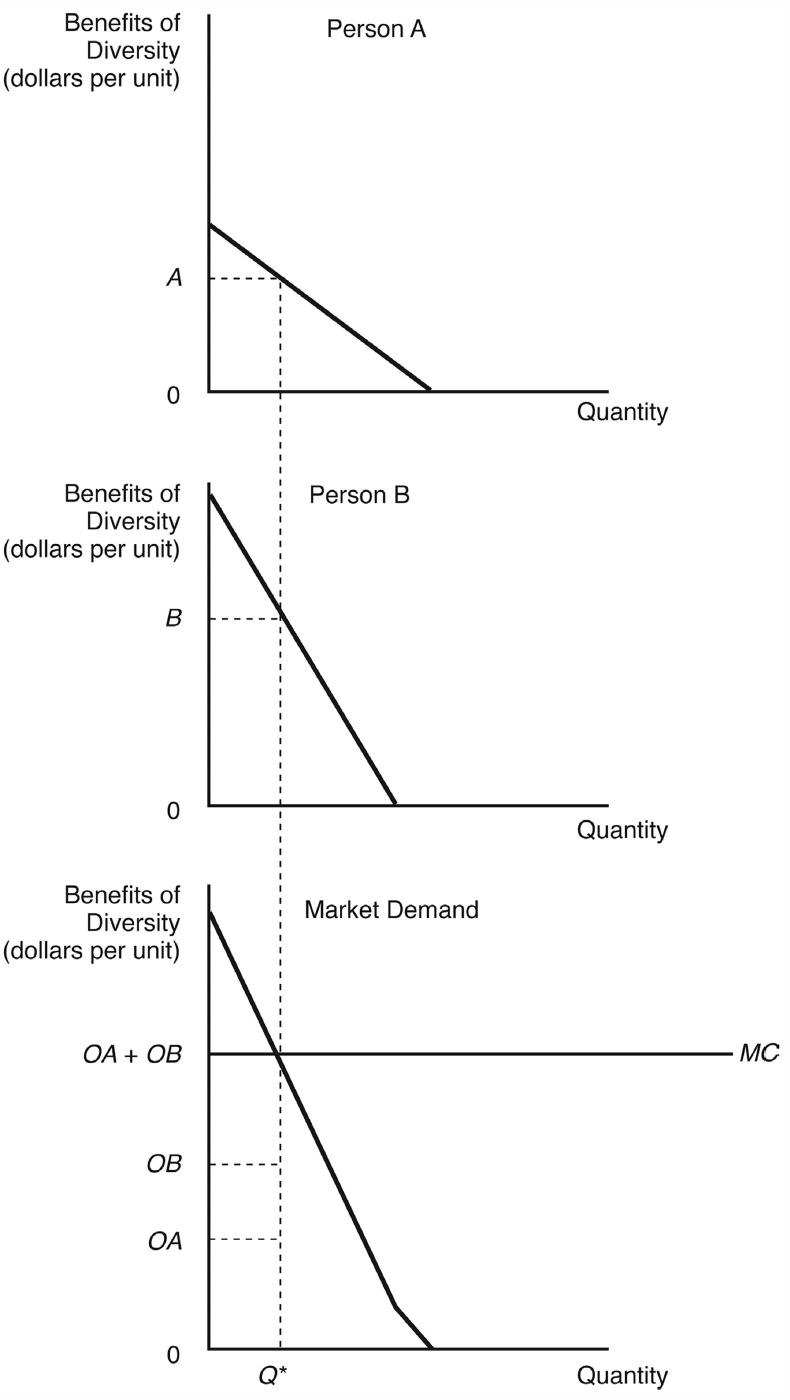Lecture 6
Property Rights, Externalities, and Natural Resource Problems
September 9, 2024
The Economic Approach: Property Rights, Externalities, and Natural Resource Problems
Externalities as a Source of Market Failure
Public Goods
Public goods are goods enjoyed in common (e.g. the warning service provided by a lighthouse)
One key characteristic of public goods is that they are non-excludable
- A good is excludable if the provider of the good can prevent people who have not paid for it from using or consuming it.
The other key characteristic of public goods is that they are non-rivalrous
- A good is rivalrous if its consumption by one individual reduces its availability for consumption by others.
Externalities as a Source of Market Failure
Public Goods

The top two graphs show individual demand for preserving biodiversity among two people, \(A\) and \(B\).
The market demand curve is represented by the vertical summation of the two individual demand curves.
- If everyone can simultaneously consume the same level of biological diversity, market demand is the vertical sum, not the horizontal sum, of individual demand curves.
The allocation that maximizes economic surplus is \(Q^{*}\), the allocation where the demand curve crosses the MC curve.
Externalities as a Source of Market Failure
Public Goods

The two consumers have very different marginal willingness to pay from the efficient allocation of this good (\(OA\) versus \(OB\)).
- An efficient pricing system would require charging a different price to each consumer.
In the absence of excludability, all consumers have an incentive to understate the strength of their preferences to try to shift more of the cost burden to the other consumers.
Therefore, inefficiency results because each person can become a free rider on the other’s contribution.
Externalities as a Source of Market Failure
Public Goods

Because biodiversity is non-rival in consumption and non-excludable, consumers receive the value of any biodiversity purchased by other people.
These properties of the public good diminishes incentives to contribute, so the public good will be under-supplied.
The privately supplied amount may not be zero, because some diversity is likely to be privately supplied.
- Relying solely on the private provision of public goods result in the preservation of a smaller-than-efficient amount of biological diversity.
Imperfect Market Structure
Asymmetric Information
A situation where one or more parties have more information than the others.
Asymmetric information creates problems for the market when it results in a decision-maker knowing too little to make an efficient choice.
Imperfect Market Structure
Asymmetric Information
- Example: Consumer preference for organic food
- Problem: Difficulty in distinguishing genuine organic produce
- Causes:
- Easy for producers to falsely claim organic status
- Consumers lack accurate information
- Consequences:
- Consumers unwilling to pay premium for “organic” produce
- Reduced profits for genuine organic farmers
- Inefficiently low output of organic produce
Imperfect Market Structure
Government Failure
Government failure, like market failure, can lead to inefficient outcomes in environmental resource allocation
Root cause: improper incentives in political processes
Rent seeking: special interest groups use lobbying to secure favorable legislation
Rent seeking often increases benefits for the group but lowers overall societal surplus
Reasons why losers don’t protect their interests:
- Voter ignorance (rational due to high information costs and low impact of single vote)
- Difficulty in organizing diffuse groups with small individual impacts
- Free-rider problem in opposing special interests
Imperfect Market Structure
Government Failure
- Forms of rent seeking:
- Seeking tariffs or price floors
- Pursuing regulations that disproportionately affect competitors
- Obtaining subsidies to transfer costs to taxpayers
- Other sources of inefficient policy:
- Government acting without full information
- E.g., US EPA required the addition of a chemical substance to gasoline to promote cleaner combustion. However, this resulted in unintended water pollution.
- Government acting without full information
Imperfect Market Structure
Government Failure
- Key takeaway:
- Blind faith in one institution or another is no substitute for rational choices that take the specific context into consideration
- Environmental problems arise from divergence between individual and collective objectives
- Solution:
- Re-align individual incentives with collective objectives